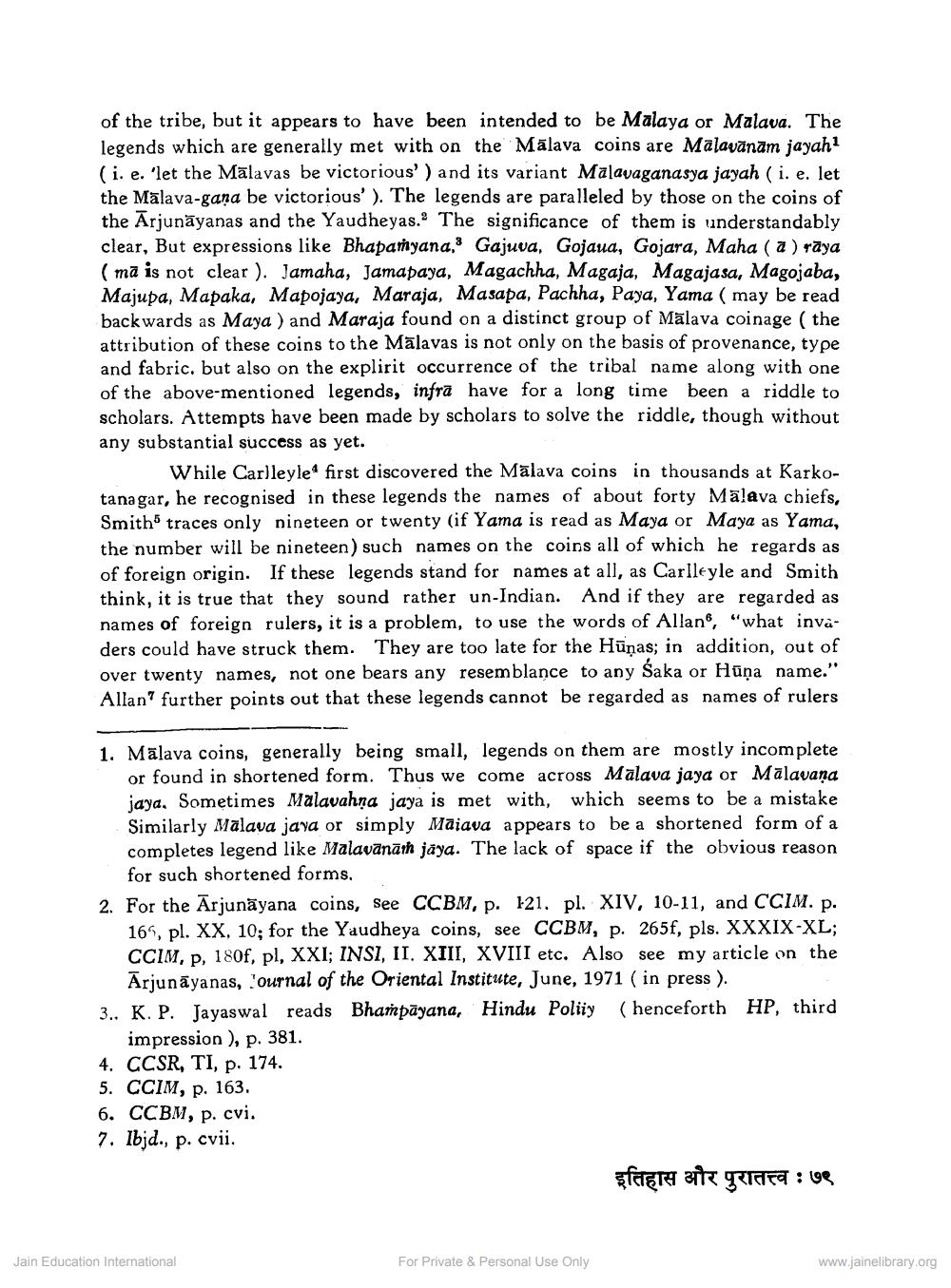Book Title: Coins of the Malavas of Rajasthan Author(s): Kalyan Kumar Das Gupta Publisher: Z_Nahta_Bandhu_Abhinandan_Granth_012007.pdf View full book textPage 3
________________ of the tribe, but it appears to have been intended to be Malaya or Malava. The legends which are generally met with on the Mālava coins are Malavānām jayah1 (i. e. 'let the Mālavas be victorious') and its variant Malavaganasya jayah (i. e. let the Mālava-gana be victorious'). The legends are paralleled by those on the coins of the Arjunayanas and the Yaudheyas. The significance of them is understandably clear, But expressions like Bhapamyana, Gajuva, Gojaua, Gojara, Maha ( a ) rāya ( ma is not clear ). Jamaha, Jamapaya, Magachha, Magaja, Magajasa, Magojaba, Majupa, Mapaka, Mapojaya, Maraja, Masapa, Pachha, Paya, Yama ( may be read backwards as Maya ) and Maraja found on a distinct group of Malava coinage (the attribution of these coins to the Mālavas is not only on the basis of provenance, type and fabric, but also on the explirit occurrence of the tribal name along with one of the above-mentioned legends, infra have for a long time been a riddle to scholars. Attempts have been made by scholars to solve the riddle, though without any substantial success as yet. While Carlleyle" first discovered the Mālava coins in thousands at Karkotanagar, he recognised in these legends the names of about forty Malava chiefs, Smith traces only nineteen or twenty (if Yama is read as Maya or Maya as Yama, the number will be nineteen) such names on the coins all of which he regards as of foreign origin. If these legends stand for names at all, as Carlleyle and Smith think, it is true that they sound rather un-Indian. And if they are regarded as names of foreign rulers, it is a problem, to use the words of Allane, "what invaders could have struck them. They are too late for the Hūņas; in addition, out of over twenty names, not one bears any resemblance to any Saka or Hüņa name." Allan' further points out that these legends cannot be regarded as names of rulers 1. Mālava coins, generally being small, legends on them are mostly incomplete or found in shortened form. Thus we come across Malava jaya or Mālavana jaya, Sometimes Malavahna jaya is met with, which seems to be a mistake Similarly Malava java or simply Maiava appears to be a shortened form of a completes legend like Malavānām jaya. The lack of space if the obvious reason for such shortened forms. 2. For the Arjunäyana coins, See CCBM, p. 121. pl. XIV, 10-11, and CCIM. p. 164, pl. XX, 10; for the Yaudheya coins, see CCBM, p. 265f, pls. XXXIX-XL; CCIM, P, 180f, pl, XXI; INSI, II. XIII, XVIII etc. Also see my article on the Arjunāyanas, Journal of the Oriental Institute, June, 1971 (in press ). 3.. K.P. Jayaswal reads Bhampāyana, Hindu Poliiy (henceforth HP, third impression ), p. 381. 4. CCSR, TI, p. 174. 5. CCIM, p. 163. 6. CCBM, p. cvi. 7. Ibid., p. cvii. इतिहास और पुरातत्त्व : ७९ Jain Education International For Private & Personal Use Only www.jainelibrary.orgPage Navigation
1 2 3 4 5 6
